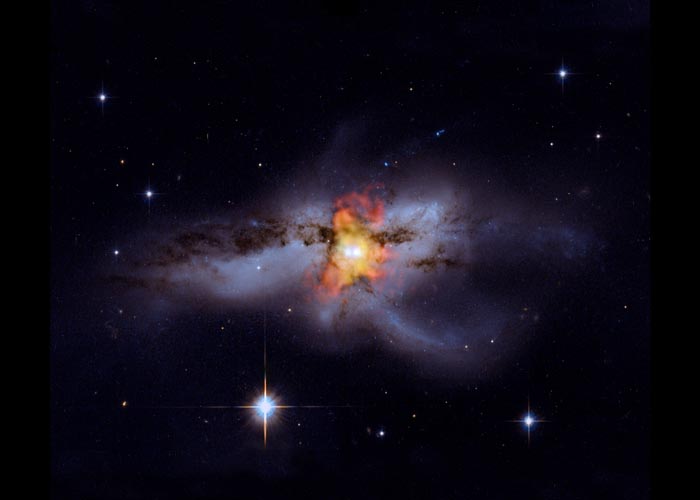
Black Holes Go "Mano A Mano"
Black Holes, Normal Galaxies & Starburst Galaxies
RA 16h 52m 59s Dec +02° 24' 01.70"
Ophiuchus
May 11, 2006
40 hours
red (0.5-1.5 keV); green (1.5-5 keV); blue (5-8 keV)
ACIS
About 330 million light years (redshift = 0.0245)
Image is 124 arcmin across
X-ray (NASA/CXC/MIT/C.Canizares, M.Nowak);
Optical (NASA/STScI)
October 06, 2009
2008 Image 2009 Image 2015 image
ABOUT THIS IMAGE:
This image of NGC 6240 contains new X-ray data from Chandra (shown in red, orange, and yellow) that has been combined with an optical image from the Hubble Space Telescope originally released in 2008. In 2002, the discovery of two merging black holes was announced based on Chandra data in this galaxy. The two black holes are a mere 3,000 light years apart and are seen as the bright point-like sources in the middle of the image.
Scientists think these black holes are in such close proximity because they are in the midst of spiraling toward each other - a process that began about 30 million years ago. It is estimated that the two black holes will eventually drift together and merge into a larger black hole some tens or hundreds of millions of years from now.
Finding and studying merging black holes has become a very active field of research in astrophysics. Since 2002, there has been intense interest in follow-up observations of NGC 6240 by Chandra and other telescopes, as well as a search for similar systems. Understanding what happens when these exotic objects interact with one another remains an intriguing question for scientists.
The formation of multiple systems of supermassive black holes should be common in the Universe, since many galaxies undergo collisions and mergers with other galaxies, most of which contain supermassive black holes. It is thought that pairs of massive black holes can explain some of the unusual behavior seen by rapidly growing supermassive black holes, such as the distortion and bending seen in the powerful jets they produce. Also, pairs of massive black holes in the process of merging are expected to be the most powerful sources of gravitational waves in the Universe.